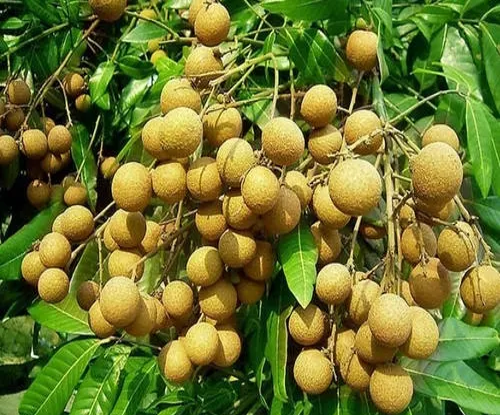Dimocarpus longan
Overview
Dimocarpus longan, commonly known as longan or dragon's eye, is a fruit tree belonging to the Sapindaceae family and closely related to lychee. It is native to southern China and is renowned as one of the iconic fruit trees in southern and southeastern regions of the country. The primary cultivation of this tree is for its delicious fruit. The name "longan" originates from the fruit's resemblance to an eyeball when the outer shell is removed. The seeds of the longan are small, round, hard, and possess a glossy and lacquered appearance.

Geographical Distribution
Longan is native to southern China and widely cultivated from southwestern to southeastern China, with Fujian being the most abundant, followed by Guangdong. It can also be found growing in the wild or semi-wild in sparsely forested areas of Yunnan, southern Guangdong, and Guangxi.
Despite its long-standing reputation in China, longan is still considered a relatively novel fruit on the global stage. The first documented mention of longan in Europe dates back to 1790 when the Portuguese Jesuit botanist Joao de Loureiro included it in his collection Flora Cochinchinensis.
Currently, longan is grown in southern China, northern Thailand, Malaysia, Indonesia, Cambodia, Laos, Vietnam, India, Sri Lanka, the Philippines, Australia, the United States and Mauritius, and Bangladesh.
Application
- Edible uses: Longan fruit is sweet and juicy and is often used in soups, snacks, desserts and other foods, in addition to being eaten raw like other fruits.
- Health benefits: Longan is characterized by its warm and sweet nature, which is believed to have beneficial effects on the heart and spleen. It is known to nourish the qi and blood, offering excellent nourishing and tonic properties.
- Other industrial applications: Longan seeds contain starch and can be processed to make wine. The wood of the longan tree is solid, heavy, and has a dark reddish-brown color. It is highly resistant to water and moisture, making it an excellent material for shipbuilding, furniture production, and intricate craftsmanship.
Genome sequencing
In 2017, the Institute of Horticultural Biotechnology at Fujian Agriculture and Forestry University, in collaboration with BGI, completed the reference genome of Honghezi, a Chinese longan variety. The reference genome was sequenced using the Illumina HiSeq 2000 system with the whole-genome shotgun method. All high-quality reads were assembled into 51,392 contigs and 17,367 scaffolds, with a total size of 471.88 Mb, excluding gaps. The N50 values for the contigs and scaffolds were 26.04 kb and 566.63 kb, respectively. The assembled genome drafts were estimated to contain 31,007 genes and 261.88 Mb of repetitive sequences.
In 2022, the Guangdong Academy of Agricultural Sciences' Institute of Fruit Tree Research, in collaboration with Peking University's Institute of Modern Agriculture, successfully deciphered the reference genome of the cultivated longan variety known as "JDB." The researchers utilized a combination of PacBio SMRT, Illumina, and Hi-C sequencing technologies to achieve a chromosome-level reference genome for longan. The assembled genome had a size of 455.5 Mb and contained a total of 40,420 protein-coding genes fixed on 15 chromosomes. The contig N50 reached 12.1 Mb, and the scaffold N50 was 29.5 Mb.
Reference
1.段海来,千怀遂,俞芬,等. 华南地区龙眼的温度适宜性及其变化趋势[J]. 生态学报,2008.
2.卢美英,郭蔚,潘介春,等. 世界荔枝龙眼生产贸易分析及应对措施[J]. 世界农业,2004.
3.周小雷, 袁经权, 王硕,等. 中药龙眼的现代研究进展[J]. 2013.
4.Pham, V.T., Herrero, M. and Hormaza, J.I. Fruiting pattern in longan, Dimocarpus longan: from pollination to aril development[J]. Annals of Applied Biology, 2016.
5.Lim T K, Lim T K. Dimocarpus longan subsp. longan var. longan[J]. Edible Medicinal And Non-Medicinal Plants, 2013.
6.Lin Y, Min J, Lai R, et al. Genome-wide sequencing of longan (Dimocarpus longan Lour.) provides insights into molecular basis of its polyphenol-rich characteristics. Gigascience. 2017;6(5):1-14. [OpenLBID: OLB-PM-28368449]
7.Wang J, Li J, Li Z, et al. Genomic insights into longan evolution from a chromosome-level genome assembly and population genomics of longan accessions. Hortic Res. 2022;9:uhac021. [OpenLBID: OLB-PM-35184175]
| Data Statistics | |
|---|---|
| Taxonomy ID | 128017 |
| Projects | 4 |
| Samples | 185 |
| Genomes | 2 |
| Variations | 28,719,122 |
| Expressions | 3 |
| Reference | longan_shixia |
| Refgenes | 37,142 |
| Cultivars | 68 |